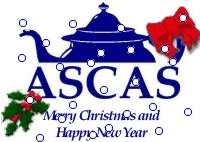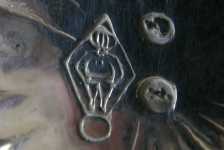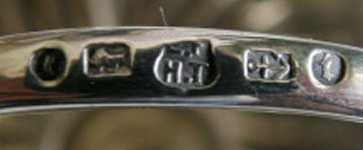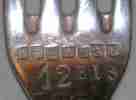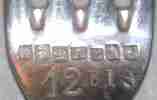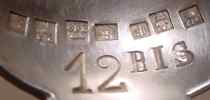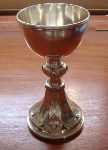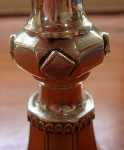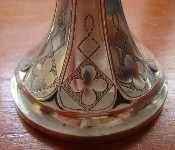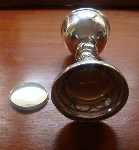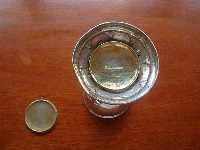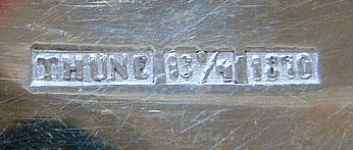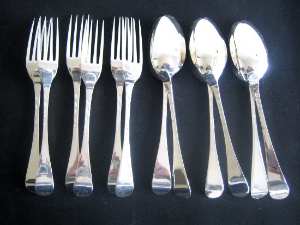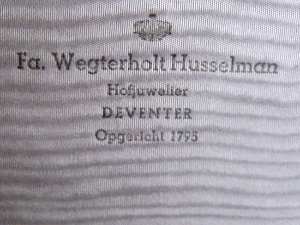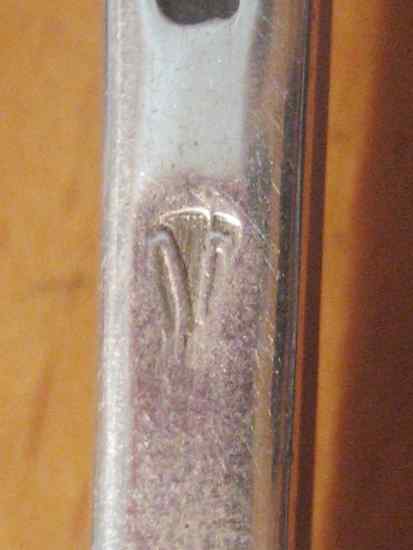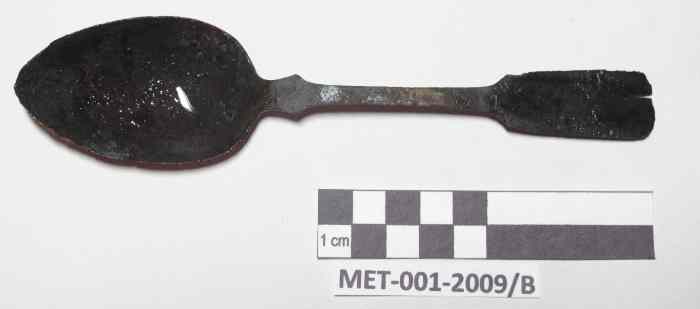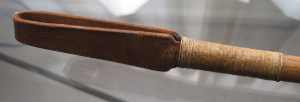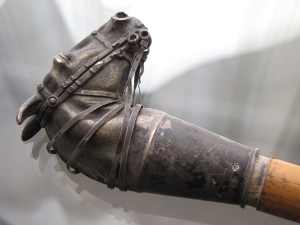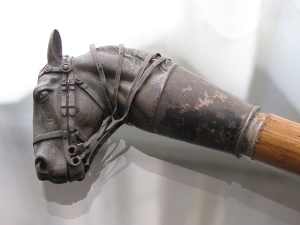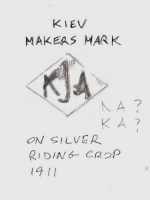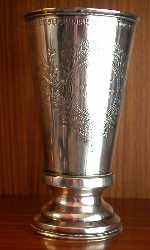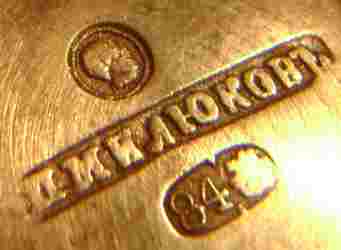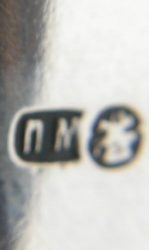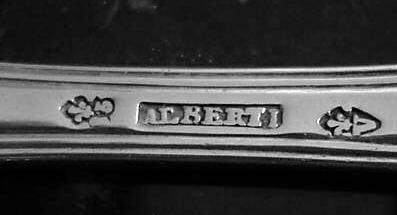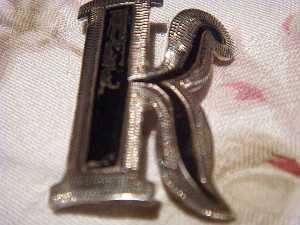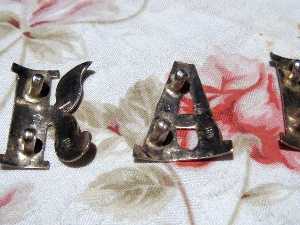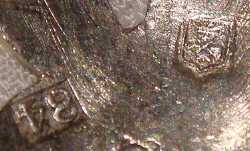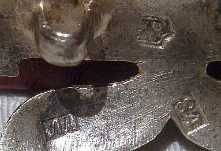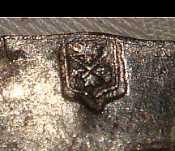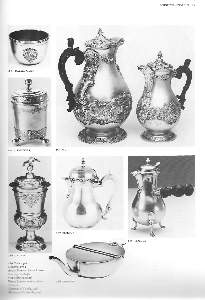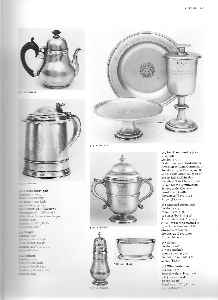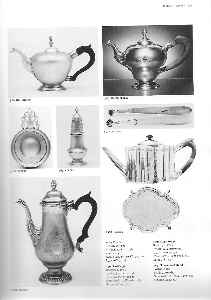2011 ASCAS membership
No fees are requested nor accepted for ASCAS membership.
Members still interested to ASCAS and its activity are invited
to send an e-mail to
confirming their 2011 membership (the simplest way is to
use the 'reply' button on our December e-mail).
I apologize for this little effort asked to whomever appreciates
and supports ASCAS activity.
No action is required to unsubscribe. Members not confirming
their membership will be automatically deleted from the sending
of our monthly Newsletter and will be suspended on
February 2011.
Please accept my best wishes for a happy Christmas and a
prosperous New Year and my thanks for your present or past
appreciation of my work.
Giorgio Busetto
ASCAS Secretary
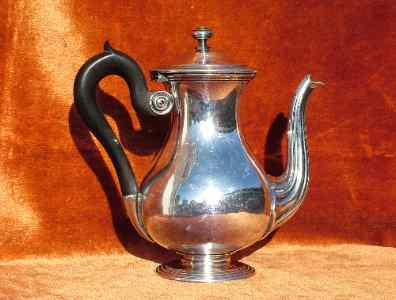
Prof. David N. Nikogosyan presents:
Numeration in Silver-Plated Christofle Hollow Ware
and its Application to Items Dating:

.....It is a remarkable fact that every relatively large
piece of hollow ware, issued by the famous French
silversmith foundry Christofle in 1846-1930, possesses a
so-called numbering, i.e., each item is marked by its
own ordinal number. No other company in the world made
such marking. Indeed, Christofle had even two numberings.
The first one was used from c.1846 until 1862 (or until
1865) and was running from 1 up to at least 337243,
which is engraved on the bottom of a small Christofle
coffee-pot from my collection ....
click here 
|
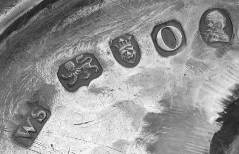
Giovanni Ciceri presents:
Determining the date on London Assay Office Marks -
1776-1795: 
.....At the London Assay Office, each series refers to
20 years, starting with the date letter "a" and ending
with the date letter "u" or "v". Only twenty letters of
the alphabet have been used, excluding: j, v (or u), w,
x, y and z. Note that the last letter of each cycle can
be an "u" or a "v", but this is probably due to the fact
that in the classic Latin language and alphabet there
was no difference between "u" and "v". There is only an
exception in the 18th century, prior the introduction of
the Britannia standard (1696), when the cycle lasted 19
years and ended with the letter "t" ....
click here 
|
Welcome to new ASCAS members:
Doug Bartick - England UK
Ricardo Ferreira - Brazil
Donald Haines - The Netherlands
Mauro Liconte - Italy
Alex Shkrobinets - USA
Brian Smeathers - Canada
Members' Window # 79

Postnikov presents:
Russian Napkin Rings 
The napkin ring is a bourgeois invention. The first
examples were probably plain or embroidered tapes
created by the housewife to personalise the family's
napkins between weekly wash-days.
Napkin rings in silver were the result of the growing
wealth of the middleclass. Silver napkin rings started
in France about 1800 and by 1840 they had spread to most
western countries....
click here 
|
Paul Skippen writes:
... I recently acquired a solid silver double salt cellar. The
marks on it are quite clear and while I could identify most -
Birmingham 1883, made by Horace Woodward & co-Edgar Finley &
Hugh Taylor - there is a mark which has the shape of a "kite"
mark which has me baffled.
Can you or any of your readers help please?
Many thanks
Paul Skippen
The "fakir" is, simply, the trade mark of Horace Woodward &
Co. This is common practice on silver plate marks. Rare in
sterling silver markings. You can see an image in the "Figural
Trade Marks" page of my Dictionary at
http://www.silvercollection.it/dictionarytrademarks.html
Giorgio Busetto
Your set is an uncommon and interesting item (a sample of
the pattern?). I identify five of the seven make's marks: left
to right, 2 Compere Leontine Vve – 4 Henin & Cie - 5 Emile
Puiforcat – 6 Henry Soufflot – 7 Tetard freres.
I hope that someone of our readers will be able to answer to
your question.
Giorgio Busetto
Malcolm Stander writes:
...I have found this interesting piece what looks like an arts &
crafts chalice. On closer inspection underneath I discovered it
has a concealed apartment.
On removing lid underneath I have discovered it is a communion
cup. It has a section space for the communion wafer biscuit.
This apartment is gilded inside as well as the inner section of
the lid.
Inside it is marked Thune and what looks like 13 1/4 and dated
1870.
Not one of any knowledge on this subject matter I asked my
neighbour who is catholic and they say it is used as a communion
cup and taken to someone's house by the priest when they are
sick.
All I know that Thune is a famous silversmith co from Oslo
Norway.
Any of ASCAS members have any more info on this type of
communion cup and would this be considered a rare piece as Thune
were prolific makers.
It stands 13 cm tall and the base is 7cm across with wafer
department 4cm across.
Kind regards
Malcolm Stander
I believe that this is a small chalice used to celebrate
Mass on travel or in private homes (its measure is a largely
smaller than those used in the church).
Further information will be welcome.
Giorgio Busetto
Jakob F. writes:
...I have a very nice silver flatware that, according to its
marks, I thought to be Dutch, 18th century. However after
talking to a few experts they could not identify in 100% if it
is or not 18th century.
I would kindly ask for your assistance
Kind Regards,
Jakob
Ingrid Frederick writes:
...I am a conservation and restoration student and am currently
researching for my thesis on a spoon which was recovered from an
archaeological excavation in Cartagena, Colombia. I would like
to know if you can please help me recognize any of these marks
on the spoon that I haven't been able to identify after looking
through all of the pictures at your website. I will attach two
pictures.
I greatly appreciate your help.
Sincerely,
Ingrid Frederick
Norah Cooper writes:
...I found your site while looking to identify the maker of a
silver horse head on the handle of a riding crop.
This piece was handed down in my family by my great uncle who
served under Franz Joseph in WWI.
He took it off a Prussian officer who in turn most likely took
it off a Russian or Bulgarian officer.
I am attaching photos of the piece as well as a photo of the
silver mark I found on your site. I have done a drawing of the
tiny mark. Neither a rubbing or a photograph gives a clear
result so I hope this is helpful.
The makers mark I did not find on your site.
The inscription on the piece says:
Concour-hipigue
I npuer
Kpaeabnua
19 29/VII 11 i.
Do you have any idea where to go from here to identify the
maker? Have you ever seen a similar riding crop?
Thank you so very much for any advice you may offer.
Norah Cooper
Michael writes:
...You have helped me in the past and, I'm afraid that I am
going to bother you again.
I have a Russian Silver Vase with a hallmark I cannot identify.
The Vase is 17.2 cm high, 9.2 diameter at the top, 7.3 at the
bottom and weighs 246 g.
I am attaching photos with the markings. Any help will be
greatly appreciated
Best regards
Michael
The maker of your vase is Petr Pavlovitch Miliukov, active
in Moscow, 1877-1912.
Giorgio Busetto
David Mckinley writes:
...Dear Giorgio,
Thanks again for the newsletter
(November newsletter).
I found both articles by Lise Moor and Christophe Ginter most
interesting and wonder if you would be kind enough to ask either
or both of them on my behalf what is the significance, if any,
of the crown over the maker's initials in his mark. Many
Huguenot silversmiths in England could be identified by this
feature and I wonder if it has some particular meaning?
My very best wishes,
David Mckinley
To the best of my knowledge, there is no specific
significance attached to the crown over the makers' initials.
The crown is a usage ("un usage") without any further meaning.
Let's be more precise:
(1) in many parts or towns in the French Kingdom, there is no
crown linked with the makers' marks. Many examples:
- Toulouse, where the typical maker's mark is made of the full
name of the master, sometimes with the first initial of his
first name, and without any crown,
- Burgundy or Franche-Comté, where the usual maker's mark
contains the city armorials, this usage is defined by the
corporation status, and you don't find any crown but sometimes a
lilly flower,
- the Lorraine (Nancy) maker's mark bears only a city symbol
together with the maker's initials, no crown,
- in Alsace, no crown but the full name of the maker in a
cartouche... etc, etc
Again, most of this specifications are linked with some usage
and rules that makers themselves created within their
corporations.
(2) Before giving a reply to your request, I read through some
status and I didn't find any compulsory demand attached to the
crown and demanded for instance by the royal authority.
(3) Please note that in other parts of France (Normandy, ...)
the crown is never over the initials but over a city symbol: "licorne"
in Saint-Lô,"agneau pascal" in Rouen, "léopard" in Caen, etc.
(4) in Paris, a compulsory status is imposing not a crown but a
crowned lilly flower over the makers' initials. A "usage" again.
The same occurs in many towns in Brittany, etc
(5) To make it short, a crown over the initials seems to be the
"typical" French Mark for makers. In fact ... it is not.
I hope this message will be of some help for you.
Christophe Ginter
Replies to questions
Postnikov writes:
... This letters were part of a leather strap (bracelet) or
belt, not worn by Cossaks, only by tourists.
The Caucasus was an important tourist center at that time, the
Tzar and a lot of nobilities owned very nice palaces there. All
objects with the inscription Kafkas were souvenirs and had
nothing to do with the Cossaks!
Town mark Novocherkassk in use 1847-1880
Maker: Lasarev Amoartsimovitsch
Silver content: 84 Zolotniki = 875/1000
Regards
Postnikov
Lazar Freidgeim writes:
... I think you are right – it is part of a belt. They have
been made as Caucasian souvenir in 1890-1910s. A correct word is

This word means Caucasus
Lazar Freidgeim
Pierre Gagnaux writes:
... It's the word Caucasus in Cyrillic. It is a classic
souvenir bought during vacancies at the Mer Noire during the
tzars period. They were surely on a tissues belt. The
silversmith is unknown to me. I've the same mark on a belt
buckle I sold this summer.
I know those items from Caucasus (a lot were made in
St-Petersburg...) because I've sold nearly all the "souvenir"
nielloed items from Caucasus, and keep only the really good
things.
Pierre
Adam Goldsmith writes:
... Perhaps I can put some light on the Russian silver
question from Malcolm Stander. He is quite correct on the town
mark being Novocherkassk with the mark being used until 1880.
The maker's mark of L A is not listed. I have several Niello
Kafkas pieces which seem to be sold as a reminder of visiting
the Caucasus mountains. I do not think that these letters are
for a belt but look more as if they would have been sown onto a
piece of material – at least that is my suggestion!
Adam Goldsmith
In this column we present a page
obtained from makers' brochures, books, auction catalogs,
advertising or whatever other printed paper, related to silver,
that may be of interest for ASCAS members.
The images will be published at a "low resolution" level and for
private and personal use only
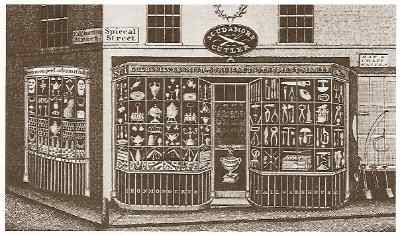
|
This month we present an image of the
SHOPFRONT OF JEREMIAH SCUDAMORE
Cutler at 1 Spiceal Street, Birmingham
as was represented in the 1823 Wrightson's
Triennial Directory. The various sign shops presents
the firm as Gold & Silversmith, Surgical Instrument
Maker
Ironmongery & Nailwarehouse
|
"A WORD per MONTH"
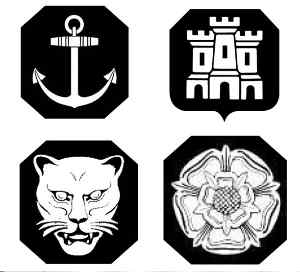
|
UK CONTEMPORARY SILVER AND GOLD HALLMARKING
The
British hallmarking system was widely modified in 1999
and some of the traditional marks became optional
symbols applied only on request alongside the compulsory
hallmarks.
Henceforth, future generation of collectors will fewer
and fewer find the full set of hallmarks that for
hundreds of years has characterized the British
silver...
more
|
"A SILVERSMITH per MONTH"
|
|
DEYKIN & SONS
DEYKIN & HARRISON
DEYKIN & HARRISON LTD
The business was
established in 1781 as gilt button makers and was
carried on by James Deykin and William Henry Deykin
until 1848. The firm was active in its factory, Venetian
Works, 5 and 6 Jennens Row, Dale End, Birmingham, mainly
as buttons manufacturer, until 1854 when production of
electroplated wares was introduced.
At this time the firm traded as J. & W. Deykin (buttons)
and Deykin & Sons (electroplated wares) under the
partnership of James Deykin and William Redfern Deykin.
The production of buttons was abandoned in 1877....
more
|
"A BOOK ON MY SHELF"
In this column we present books, new
or ancient, dealing with silver in all its aspects (history,
marks, oddities...). This isn't a "book review" but only a fair
presentation of some useful "tools" that anyone may have in the
shelf of his bookcase.
ASCAS members are invited to contribute to this column
(click to enlarge images)
The "book on my shelf" of this month presents:
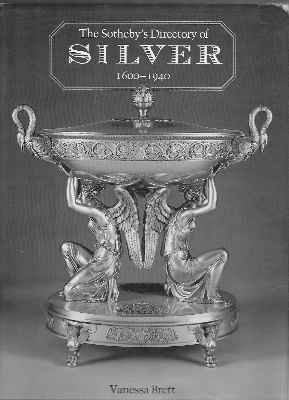
|
The Sotheby's Directory of
SILVER
1600-1940
by
Vanessa Brett
Philip Wilson Publishers Ltd for Sotheby's
Publications
London
1986
This book cover the work of silversmiths in
Europe and North America from about 1600 to
1940, offering a wealth of information and
illustration.
It differs from many other publications on
silver in that the main emphasis has been placed
on the silversmiths, rather than on the various
categories of object which they produces or on
the different periods or styles in which they
worked.
Basing her choice on sales of silver held at
Sotheby's from the 1920s until 1984, Vanessa
Brett has arranged her material (which comprises
2000 objects, each of them illustrated) by
country of origin, grouped under the makers, who
are listed, wherever possible, in chronological
order of registration of their marks or of
achieving master's status.
The makers represented are from Germany,
Austria, the countries historically linked with
them and Switzerland, the Low Countries, Great
Britain and Ireland, North America, France,
Italy, Scandinavia and Russia...
|
"A CREST per MONTH"
In this column we present images and
descriptions of Crests and Mottoes of British, Irish and
Scottish families as engraved on silver items.
BARTAN, BARTANE, BARTAIN, BOUWEN, CARROL, CAROLL,
DUKES, HARTFORD, LINDSAY, MARMYON, QUICKE, SHED,
WESTLEMORE, WHITAKER
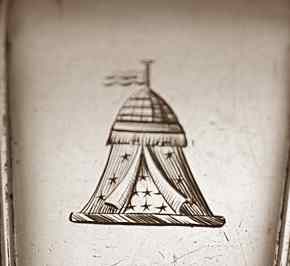
|
A tent, a flag.
The crest of Bartan (Scotland), Bartane (Scotland),
Bartain (Scotland), Bouwen (England), Carrol (Ireland),
Caroll (Ireland), Dukes (England), Hartford (England),
Lindsay (Earl of Balcarres, Scotland), Marmyon
(England), Quicke (Devonshire), Shed (England),
Westlemore (England), Whitaker (England).
The crest was found in a silver plate spoon marked
Elkington & Co, date 1878
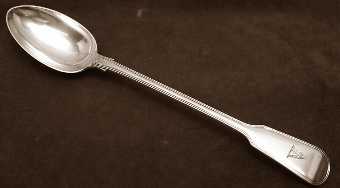

|
Closing our December 2010 edition of ASCAS
Newsletter I hope you have appreciated its content.
Your comments, suggestions and advice will be of great help.
My thanks to Giovanni Ciceri,
Norah Cooper, Jayne Dye, Ingrid Frederick, Lazar Freidgeim,
Pierre Gagnaux, Christophe Ginter, Adam Goldsmith, David
Mckinley, David N. Nikogosyan, Postnikov, Paul Skippen, Malcolm
Stander, Andy Urbach, Raphael Zaphiropoulos, for their
invaluable contributions.
Giorgio Busetto
Secretary
DISCLAIMER AND PRIVACY POLICY
ASCAS is a community of people having a common
interest in antique silver.
It is a non-profit association without commercial links.
Membership is open to whomever has a true interest in
this subject matter.
ASCAS has no real property and no fees are requested nor
accepted from members.
ASCAS keeps in touch with its members only through
periodical newsletters, e-mails and web-site updating
and ignores and is not responsible for any other
activity pursued by its members.
Likewise, ASCAS is not responsible for opinions,
evaluation and images displayed, and in any form
published or supplied for publication, by its members
who, in any case, maintain the property of their works
and assure the respect of national and international
legislation about Intellectual Property.
ASCAS does not have the full addresses of its members (only
town, country and e-mail address are requested for
membership).
ASCAS handles and protects with care its members' e-mail
addresses, will not disclose the addresses to third
parties, will use this information only to reply to
requests received from members and for communications
strictly related to its activity.
These rules are expressly accepted by submitting the
membership request.
|
|
 newsletter
# 79 December 2010
newsletter
# 79 December 2010







